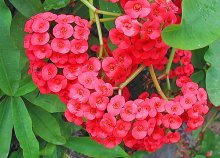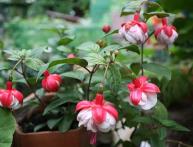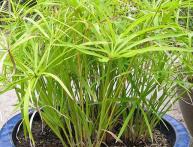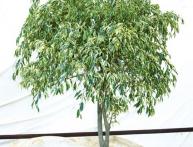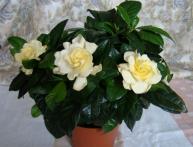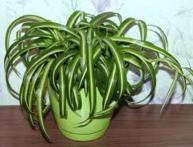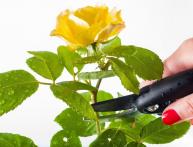Euphorbia Milya: what care should be like at home
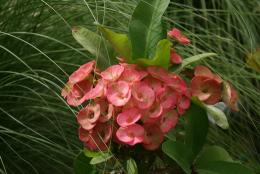
Spurge spurge (Spurge Mila) is a plant that is the most attractive and charming of its family. Euphorbia is a thorny shrub that is small in stature and has fairly massive stems on which bright green leaves grow. The natural habitat of this plant is the island of Madagascar with its arid regions, as well as Mexico.
In European countries and Russia, Euphorbia Milya is grown only in closed soil. These can be various gardens, greenhouses, general purpose premises (offices, lobbies), as well as window sills in apartments and private houses.
Content:
Description of Milkweed Mile
In the spring and autumn, the shoots of Milkweed begin to become covered with small flowers. The flower itself is not a decoration of the plant, but its bract is the part that will cause aesthetic pleasure in everyone. The color scheme can be very diverse: from white to bright pink shades. The size and color saturation fully depend on the conditions in which the plant developed.
The main feature of Euphorbia is its unpretentiousness to living conditions.
It is only necessary to maintain good lighting for the plant; Euphorbia can put up with other conditions, sometimes even not entirely favorable. The light should be as bright as possible, so it is best to even find a place for the flower to develop in direct sunlight.
If there is enough light for Euphorbia Mila, the bush will really be lush, and the flowers will be bright and large. If a plant grows in the shade, then over time it begins to stretch, the stems become thin, the number of leaves gradually decreases, and the flowers do not bring any beauty at all.
Plant care rules
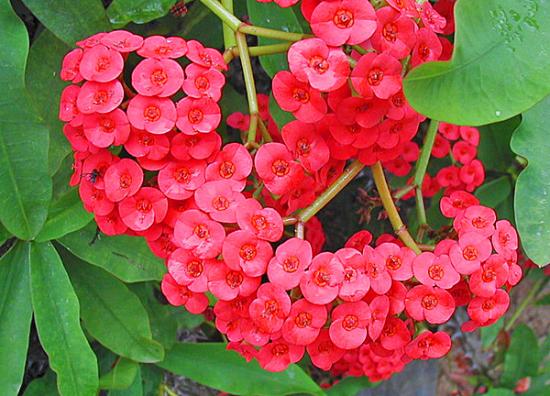
Euphorbia Mila should be watered abundantly, but rarely. The main thing is that the soil has time to dry completely. In winter, the plant is dormant, so watering should be significantly reduced, especially if there is any heating device located next to the flower. But you should not allow the soil to dry out.
This factor has a negative effect on the flower, it begins to shed yellowed leaves, which cannot but affect its aesthetic characteristics. But as soon as all necessary conditions are restored. Euphorbia recovers in a short time.
Euphorbia Mila dies from dry soil in very rare cases, for example, if you don’t water it at all for several weeks. This plant is adapted to develop in conditions with a lack of moisture. Excess moisture in the soil is much worse and more dangerous for the plant; this can lead to this. That the process of rotting of the root system of the flower will begin.
When watering, you should be careful and avoid getting drops of moisture on the leaves, in particular on the stem base, as this can lead to the active proliferation of fungi. Therefore, if in the summer the flower grows in the open air, it must be protected from precipitation. It is best to place the flower pot on a covered terrace or veranda.
Euphorbia Mila does not require humid air around you. This plant, as practice shows. It grows well and feels good in the most ordinary apartments, even in winter, when the air is very dry.
To propagate Milk Milk, it is necessary to use mainly the vegetative method. For propagation, it will be necessary to prepare stem cuttings in spring or summer, which are cut from the main bush. The milky sap is thoroughly washed off the cut with water, then it must be dried and planted in soil made from a mixture of sand and peat.
Roots will appear on average 2 months after planting. In some cases, cuttings can produce shoots even if they are simply placed in water. This method does not always work, and sometimes the cuttings simply rot.
Pests and diseases
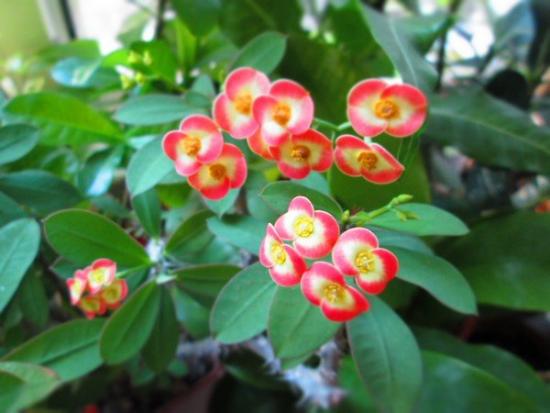
Despite the fact that Euphorbia Mila is a rather unpretentious plant, it has a number of pests that negatively affect its condition and development. Among the parasites, the following should be noted:
- aphids
- whiteflies
- scale insects
- spider mite
You can get rid of such pests either with the help of special preparations or using the manual method.Preparations for treating plants against parasites include "Decis", "Fitoverm", "Derris", as well as all products that contain a substance such as parmethrin.
If the parasites have managed to infect the leaves, they must be removed so that the infection does not spread further. If, despite observing all favorable conditions for the growth and development of the plant, the Euphorbia turns yellow and the leaves fall off, then most likely the plant is affected by a mealybug that has settled in the root system. This is a fungus that leaves marks on white roots, like small handfuls of flour.
In this case, the pot is completely disinfected and the soil is changed to another.
Roots affected by fungus must be washed with an insecticide solution. If it is not possible to completely replace the soil, you can simply boil it and then add mineral fertilizers to it.
Often problems can simply be due to improper care. Therefore, first of all, it is necessary to reconsider all the conditions in which this plant is kept. In winter, since the plant is dormant, it may change its appearance somewhat, and in a negative way, but do not be afraid of this. With spring, Euphorbia Mila will bloom and become a wonderful decoration for your home.
Video description of Milkweed Mile:
Interesting information about the vegetable garden

